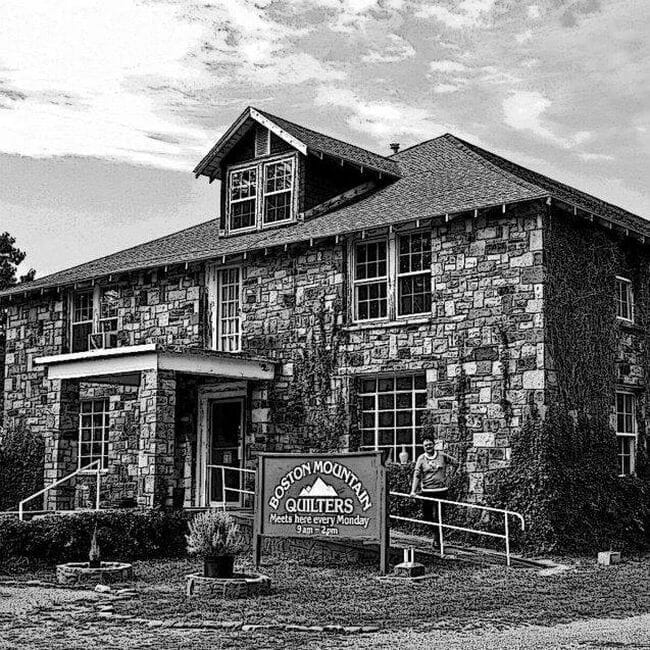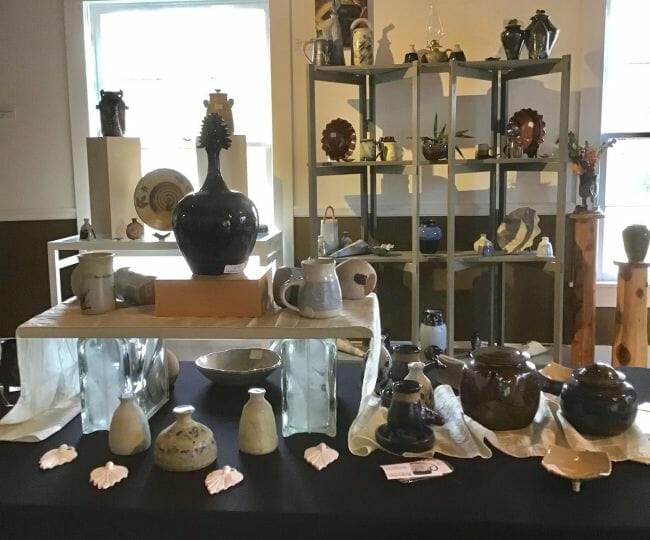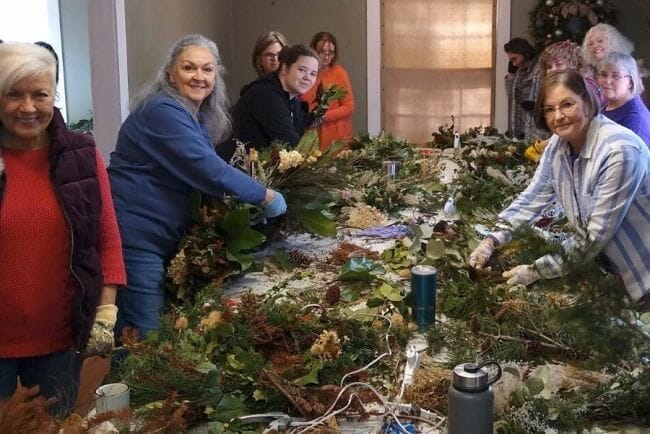

Uh oh...
It appears that you're using a severely outdated version of Safari on Windows. Many features won't work correctly, and functionality can't be guaranteed. Please try viewing this website in Edge, Mozilla, Chrome, or another modern browser. Sorry for any inconvenience this may have caused!
Read More about this safari issue.

When I was a girl, my grandmother took me to visit the Ozark Native Craft Shop on Mount Gaylor in Winslow, Arkansas. It was a dreamy place for a kid who loved to twist twigs into crowns and paint faces on rocks. Much of my admiration for traditional crafts came from my grandparents, who sold their woodcrafts and tole-painted creations at the shop and local crafts shows like War Eagle.
I am thrilled that Ozark Folkways is preserving a commitment to traditional Ozark crafts, and the vision of the original dreamer, Clara Muxen.

Like countless other travelers before her, Muxen was enchanted with the beauty of the Boston Mountains. The former schoolteacher and Catholic nun stopped on Mount Gaylor south of Winslow as she was traveling with her mother from their home in Iowa to Hot Springs, where she planned to experience the widely advertised benefits of the town’s natural spring water. Muxen eventually made a home on the mountain and began building a legacy.
Her dream was to open a community school to train local people in traditional arts and crafts and provide them with a skill and a source of income. She found a kindred spirit in a Detroit school teacher named Helen Keliher, who provided the seed money. It took three years for the exterior of the two-story stone structure to be completed, but Muxen would not live to see the interior finished out or the training program launched. It was still unfinished when she contracted tuberculosis and passed away in 1966.

When the Ozark Native Craft Association came along, the Muxen Building, as it’s now called, had been sitting empty for at least 20 years. Father Vanatius Preske, the resident priest at Our Lady of the Ozarks Mission next door (another of Muxen’s projects) convinced the Diocese of Little Rock to loan the craft association $20,000 to buy the building and pay for renovations. The association had operated the Ozark Native Craft Shop in nearby Brentwood for two years when, busting at the seams with vendors and in need of space, they moved into the Muxen Building in 1972.
The original purpose of the craft association was to provide space for the one dozen members to teach workshops and sell their work. Irene Donahue ran the shop, which was open seven days a week, and it became a popular stop for folks traveling old Arkansas Scenic Byway 71 between Mena and Fayetteville. Volunteers assisted Donahue with the shop and taught in the now-completed first floor of the building. Clara Muxen’s dreams were finally coming true.

After their move to Winslow, the Ozark Native Craft Association hosted arts and crafts fairs showcasing Ozark artisans and welcoming thousands of visitors. But by the late 1980s, increased employment opportunities in Northwest Arkansas and the River Valley encouraged many craftspeople to set aside the crafts which were no longer needed to create income. After several decades of popularity, the primitive and traditional craft market started a decline.
In light of the changes occurring around them, leadership moved their tax status to that of a charitable organization that would allow tax-exempt donations and changed their name to Ozark Folkways. The craft fairs were discontinued in 1997, and two years later drop-in traffic slowed to a trickle with the opening of Interstate 49 west of Winslow. More big dreams and visionary leaders were needed to move the organization into the 21st century

Enter Connie Wright and Rebecca Buchanan. Wright was a local familiar with Winslow and its people. She directed Ozark Folkways throughout most of the early 2000s and established the popular Kids Art Camp with the help of volunteers. They also put together the popular Ladies Painting Day and the Quilting Group events. In 2009, Buchanan took over, and with her projects and ideas rejuvenated Ozark Folkways from inside out. She oversaw interior renovations, the construction of an outdoor stage in a lovely sloping meadow behind the building, a demonstration kitchen for cooking classes and a pottery kiln for visiting potters and instructors.

In 2019, the Muxen Building and the adjacent shrine were placed on the National Register of Historic Places. The designations honor the building’s local significance in the areas of art and education: specifically, its association with Clara Muxen and her impact on the rural community. The structure is also honored in the area of architecture with local significance as an excellent example of a postwar rural Ozark vernacular public building.


Ozark Folkways’ current director, Sally Baker Williams, took the reins in December 2020 after a short stint on the board. The building’s electrical systems have been updated and Williams says they are in the process of solving some accessibility challenges. Some improvements, like the possibility of adding an elevator, will require extensive documentation and approval from the Arkansas Historic Preservation Registry since it could alter the original exterior of the building. The process is worth it, however, as the historic designation provides access to new funding sources.
Events and activities are currently being scheduled, cautiously, with the health and safety of the community in mind. The board and volunteers of Ozark Folkways remain devoted to Maxen’s dream by working to preserve, develop, teach and celebrate Ozark arts, crafts and music. Shop from home at the online gallery available here.

Events include workshops, concerts, film screenings, art shows, crafts displays and much more. Take a look at this short video for information about their events and activities and how you can get involved.
Currently, Ozark Folkways is open for visitors Friday through Sundays, from noon until 4 p.m., with the hope that they’ll open back up for regular weekday hours soon. Small groups can schedule visits at different times by contacting the staff.
Information for this story was gathered from Ozark Folkways and The Encyclopedia of Arkansas.
Photos provided by Ozark Folkways.
Join the Conversation
Leave a Comment
3 responses to “Ozark Folkways: A Celebration of Ozark Arts and Crafts”
 Leave a Reply
Leave a Reply
We do the work.
You check your email.
Sign up for our weekly e-news.
Get stories sent straight to your inbox!












 Leave a Reply
Leave a Reply
[…] Click To Read More […]
Love Ozark crafts.
[…] Ozark Folkways: A Celebration of Ozark Arts and Crafts […]